Get ready to spice up your kitchen with the vibrant flavors of Ethiopia! Whether you’re craving a cozy weeknight meal or planning a festive feast, our roundup of 22 delicious vegan Ethiopian recipes has something for every occasion. From hearty stews to fluffy injera, these dishes are sure to delight your taste buds and bring a taste of East Africa to your table. Keep reading to discover your new favorite recipe!
Spicy Lentil Stew

Zesty and warming, this Spicy Lentil Stew is a hearty embrace in a bowl, perfect for those evenings when you crave something deeply flavorful yet comforting. Its rich aroma and vibrant spices promise a culinary journey that’s both nourishing and exhilarating.
Ingredients
- 1 cup dried green lentils (I find their earthy flavor holds up beautifully against the spices)
- 2 tbsp extra virgin olive oil (my go-to for its fruity notes)
- 1 large onion, finely diced (yellow onions are my preference for their sweetness)
- 3 garlic cloves, minced (freshly minced garlic makes all the difference)
- 1 tbsp ground cumin (toast it lightly for an extra layer of flavor)
- 1 tsp smoked paprika (it adds a subtle depth that’s irreplaceable)
- 1/2 tsp cayenne pepper (adjust according to your heat preference)
- 4 cups vegetable broth (homemade is ideal, but a good quality store-bought works too)
- 1 can (14.5 oz) diced tomatoes (I love the brightness they bring)
- Salt, to taste (start with 1/2 tsp and adjust as needed)
- Fresh cilantro, chopped (for garnish, it adds a fresh contrast)
Instructions
- Rinse the lentils under cold water until the water runs clear, then drain well.
- In a large pot, heat the olive oil over medium heat until shimmering.
- Add the diced onion and cook, stirring occasionally, until translucent, about 5 minutes.
- Stir in the minced garlic, cumin, smoked paprika, and cayenne pepper, cooking for 1 minute until fragrant.
- Add the rinsed lentils, vegetable broth, and diced tomatoes to the pot, stirring to combine.
- Bring the mixture to a boil, then reduce the heat to low, cover, and simmer for 25-30 minutes, or until the lentils are tender.
- Season with salt to taste, starting with 1/2 tsp and adjusting as needed.
- Garnish with chopped fresh cilantro before serving.
Delightfully thick and velvety, this stew boasts a complex flavor profile that’s both spicy and subtly sweet. Serve it with a dollop of cool yogurt or a side of crusty bread to soak up every last drop of its rich broth.
Ethiopian Chickpea Wat
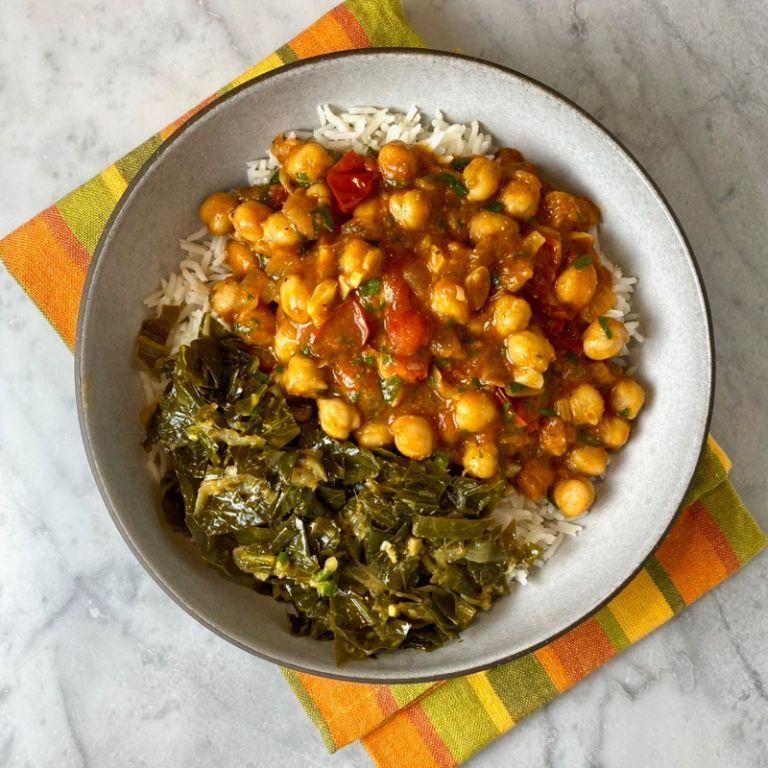
Zesty and aromatic, Ethiopian Chickpea Wat is a hearty stew that marries the earthy flavors of chickpeas with a symphony of spices, creating a dish that’s as nourishing as it is flavorful. This vegan delight, steeped in tradition, offers a comforting embrace with every spoonful, perfect for those seeking warmth and depth in their meals.
Ingredients
- 2 cups dried chickpeas, soaked overnight (I find the texture becomes perfectly tender)
- 3 tbsp extra virgin olive oil (my go-to for its fruity notes)
- 1 large onion, finely diced (the sweetness balances the spices beautifully)
- 3 cloves garlic, minced (for that essential punch of flavor)
- 1 tbsp ginger, grated (adds a bright, spicy undertone)
- 2 tbsp berbere spice (the soul of the dish, adjust heat to preference)
- 4 cups vegetable broth (homemade lends the best flavor)
- 1 tsp salt (to enhance all the wonderful flavors)
Instructions
- Drain the soaked chickpeas and rinse under cold water until the water runs clear.
- In a large pot, heat the olive oil over medium heat until shimmering, about 2 minutes.
- Add the diced onion, cooking until translucent and slightly golden, stirring occasionally, about 5 minutes.
- Stir in the minced garlic and grated ginger, cooking for another minute until fragrant.
- Sprinkle in the berbere spice, stirring constantly to toast the spices without burning, about 30 seconds.
- Pour in the vegetable broth and add the soaked chickpeas, bringing the mixture to a boil.
- Reduce heat to low, cover, and simmer for 1.5 hours, or until the chickpeas are tender. Stir occasionally to prevent sticking.
- Season with salt, adjusting to taste, and simmer uncovered for an additional 10 minutes to thicken the stew.
Exquisitely rich and velvety, this Ethiopian Chickpea Wat boasts a complex flavor profile with a slight heat that lingers pleasantly. Serve it atop a bed of fluffy injera or with a side of quinoa for a modern twist, allowing the stew to shine in all its glory.
Vegan Injera Bread
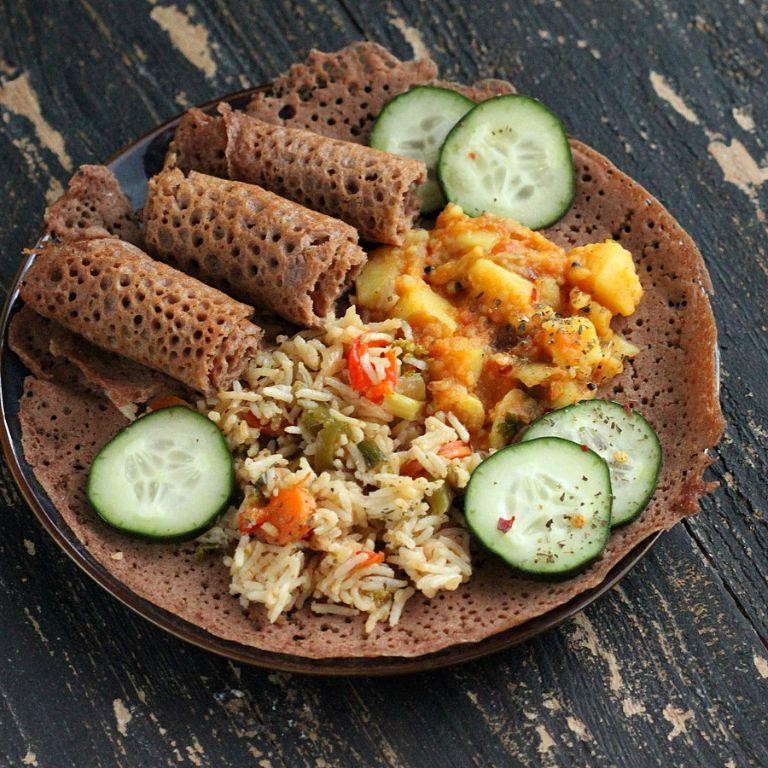
Savory, spongy, and subtly sour, Vegan Injera Bread is a staple of Ethiopian cuisine that’s as versatile as it is delicious. This gluten-free, fermented flatbread pairs beautifully with stews and salads, offering a unique texture and flavor that’s hard to resist.
Ingredients
- 2 cups teff flour (I love the nutty flavor of ivory teff, but brown works just as well)
- 1 3/4 cups lukewarm water (around 110°F for optimal fermentation)
- 1/4 teaspoon active dry yeast (a little goes a long way in this recipe)
- 1/2 teaspoon salt (I prefer fine sea salt for its clean taste)
- 1 tablespoon olive oil (extra virgin is my go-to for its fruity notes)
Instructions
- In a large mixing bowl, combine the teff flour and lukewarm water, whisking until smooth. Cover with a clean cloth and let ferment at room temperature for 24-48 hours, until bubbly and slightly sour. Tip: The longer it ferments, the tangier the flavor.
- After fermentation, stir in the yeast and salt, mixing well to incorporate. Let the batter rest for an additional 30 minutes to activate the yeast.
- Heat a non-stick skillet or griddle over medium heat (350°F) and lightly brush with olive oil. Tip: A well-seasoned cast iron skillet can also work wonders here.
- Pour 1/4 cup of the batter onto the skillet, swirling quickly to form a thin, even circle. Cook for 2-3 minutes, until the edges lift and the surface is covered with tiny holes. Tip: Don’t flip the injera; it’s traditionally cooked on one side only.
- Transfer the cooked injera to a plate and cover with a cloth to keep warm. Repeat with the remaining batter.
Not only does this Vegan Injera Bread boast a delightful spongy texture and a mildly tangy taste, but it also serves as the perfect edible utensil for scooping up your favorite dishes. Try layering it beneath a vibrant array of vegetables and legumes for an authentic Ethiopian dining experience.
Misir Wot (Red Lentil Stew)

Elegantly spiced and deeply comforting, Misir Wot is a vibrant Ethiopian red lentil stew that marries simplicity with profound flavors, perfect for a nourishing meal any day of the week.
Ingredients
- 1 cup red lentils, rinsed (I find that rinsing removes any bitterness)
- 3 cups water (for a thicker stew, reduce to 2.5 cups)
- 2 tbsp extra virgin olive oil (my go-to for its fruity notes)
- 1 large onion, finely diced (yellow onions work best for sweetness)
- 3 cloves garlic, minced (freshly minced garlic elevates the dish)
- 1 tbsp berbere spice (the heart of the dish, adjust for heat preference)
- 1 tsp salt (I prefer sea salt for its clean taste)
- 1/2 tsp ground cumin (toasted cumin adds a smoky depth)
Instructions
- In a medium pot, heat the olive oil over medium heat until shimmering, about 1 minute.
- Add the diced onion and sauté until translucent, stirring occasionally, about 5 minutes.
- Stir in the minced garlic and cook until fragrant, about 30 seconds, being careful not to burn.
- Mix in the berbere spice and ground cumin, toasting the spices with the onions and garlic for 1 minute to unlock their flavors.
- Add the rinsed red lentils and water to the pot, stirring to combine all ingredients.
- Bring the mixture to a boil, then reduce the heat to low, covering the pot with a lid.
- Simmer the stew for 20 minutes, stirring occasionally to prevent sticking, until the lentils are tender and the stew has thickened.
- Season with salt, adjusting to taste, and cook for an additional 2 minutes to meld the flavors.
Mouthwateringly rich and velvety, this Misir Wot boasts a harmonious blend of spices that coat each lentil beautifully. Serve it atop injera for an authentic experience or alongside a crisp green salad for a lighter touch.
Atakilt Wat (Cabbage and Potato Stew)

Warm and comforting, Atakilt Wat is a vibrant Ethiopian stew that marries the humble cabbage and potato with a melody of spices, creating a dish that’s both nourishing and deeply flavorful. Perfect for those evenings when you crave something hearty yet wholesome, this stew is a testament to the beauty of simple ingredients transformed by spice.
Ingredients
- 2 tablespoons extra virgin olive oil (my go-to for its fruity notes)
- 1 large yellow onion, finely diced (the sweetness balances the spices beautifully)
- 3 cloves garlic, minced (because more garlic is always better)
- 1 tablespoon ginger, grated (fresh is key here for that zing)
- 1 teaspoon turmeric (for that golden hue and earthy flavor)
- 1 teaspoon cumin (toasted and ground, if you have the time)
- 1/2 teaspoon cardamom (a little goes a long way)
- 4 medium potatoes, cubed (Yukon Golds are my favorite for their buttery texture)
- 1 small cabbage, chopped (about 4 cups)
- 2 carrots, sliced (for a pop of color and sweetness)
- 1 cup vegetable broth (homemade is best, but store-bought works in a pinch)
- Salt to taste (I start with 1/2 teaspoon and adjust from there)
Instructions
- Heat the olive oil in a large pot over medium heat until shimmering but not smoking.
- Add the diced onion, stirring occasionally, until translucent and slightly golden, about 5 minutes.
- Stir in the garlic and ginger, cooking for another minute until fragrant. Tip: Keep the heat medium to avoid burning the garlic.
- Sprinkle in the turmeric, cumin, and cardamom, stirring to coat the onions. This blooms the spices, deepening their flavors.
- Add the potatoes, cabbage, and carrots, tossing to mix with the spiced onion base.
- Pour in the vegetable broth, bringing the mixture to a simmer. Cover and reduce heat to low, cooking for 20 minutes. Tip: Resist the urge to stir too often to keep the potatoes intact.
- After 20 minutes, check the potatoes for tenderness. If they’re fork-tender, remove the lid and simmer for another 5 minutes to slightly reduce the broth. Tip: The stew should be moist but not soupy.
- Season with salt, adjusting to your preference.
Oftentimes, the simplest dishes leave the most lasting impressions, and Atakilt Wat is no exception. The potatoes melt in your mouth, while the cabbage retains a slight crunch, all enveloped in a warmly spiced broth. Serve it over a bed of fluffy quinoa or with a side of injera for an authentic Ethiopian experience.
Shiro Wot (Ground Chickpea Stew)
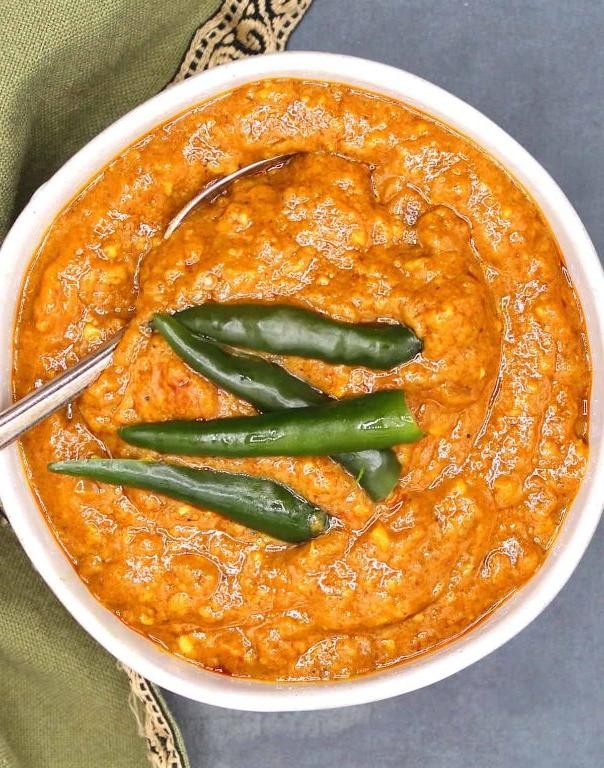
Amidst the bustling flavors of Ethiopian cuisine, Shiro Wot stands out as a comforting yet sophisticated ground chickpea stew, beloved for its velvety texture and deeply spiced aroma that promises to transport your senses straight to the heart of Addis Ababa.
Ingredients
- 1 cup finely ground chickpea flour (for an ultra-smooth texture, I like to sift mine)
- 3 tbsp niter kibbeh (Ethiopian spiced butter, but if you’re in a pinch, ghee with a dash of berbere works wonders)
- 1 large onion, finely diced (the sweetness of Vidalia onions plays beautifully here)
- 3 cloves garlic, minced (fresh is non-negotiable for that punchy aroma)
- 1 tbsp berbere spice (adjust to your heat preference, but this is the soul of the dish)
- 4 cups vegetable broth (homemade lends a richer depth, but store-bought is fine)
- Salt to taste (I start with 1/2 tsp and adjust from there)
Instructions
- In a large pot over medium heat, melt the niter kibbeh until it’s fragrant, about 1 minute.
- Add the diced onions, stirring occasionally, until they’re golden and translucent, roughly 5 minutes.
- Stir in the minced garlic and berbere spice, cooking for another minute until the spices are toasted and aromatic.
- Gradually whisk in the chickpea flour, ensuring no lumps form, then slowly pour in the vegetable broth while continuously stirring.
- Reduce the heat to low and simmer the stew for 20 minutes, stirring every 5 minutes to prevent sticking and to achieve a silky consistency.
- Season with salt, then let the stew sit for 5 minutes off the heat to thicken slightly before serving.
Delightfully creamy with a complex spice profile, Shiro Wot is best enjoyed with injera for an authentic experience, though it also pairs beautifully with a side of steamed rice for a simpler presentation.
Gomen Wat (Ethiopian Collard Greens)
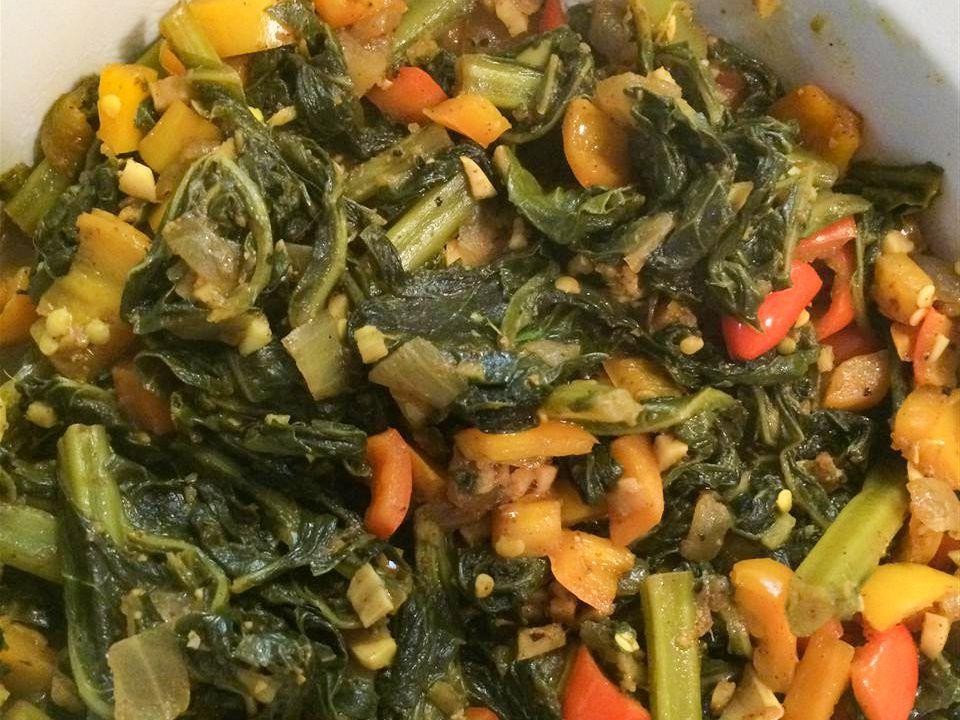
Unveiling the vibrant flavors of Ethiopia, Gomen Wat is a soulful dish where collard greens are transformed into a tender, aromatic delight, simmered with a melody of spices that whisper tales of tradition and comfort.
Ingredients
- 1 large bunch of collard greens, stems removed and leaves chopped into bite-sized pieces (I find the younger leaves more tender and flavorful)
- 3 tablespoons extra virgin olive oil (my go-to for its fruity notes)
- 1 large onion, finely diced (yellow onions work beautifully here for their sweetness)
- 3 cloves garlic, minced (freshly minced garlic elevates the dish immensely)
- 1 tablespoon ginger, freshly grated (for that zesty kick)
- 1 teaspoon turmeric (adds a golden hue and earthy depth)
- 1 teaspoon salt (adjust to your palate, but this is my sweet spot)
- 1/2 teaspoon black pepper (freshly ground, if possible)
- 1/4 cup water (to help steam the greens to perfection)
Instructions
- Heat the olive oil in a large skillet over medium heat until shimmering, about 2 minutes.
- Add the diced onion to the skillet, sautéing until translucent and slightly golden, about 5 minutes, stirring occasionally to prevent burning.
- Stir in the minced garlic and grated ginger, cooking for another 1-2 minutes until fragrant, a sign that their flavors are being released.
- Sprinkle in the turmeric, salt, and black pepper, mixing well to coat the onions evenly, which helps to bloom the spices.
- Add the chopped collard greens to the skillet, tossing them gently to mix with the spiced onion base, ensuring each leaf gets a touch of flavor.
- Pour in the water, then cover the skillet with a lid, reducing the heat to low. Let the greens steam for 20 minutes, checking halfway to stir. This slow cooking makes them wonderfully tender.
- After 20 minutes, remove the lid and increase the heat to medium-high. Cook for an additional 5 minutes to evaporate any excess liquid, concentrating the flavors.
Kaleidoscopic in flavor, the Gomen Wat emerges with a silky texture and a harmony of spices that dance on the palate. Serve it alongside injera for an authentic experience or as a vibrant side to grilled meats for a contemporary twist.
Azifa (Ethiopian Lentil Salad)
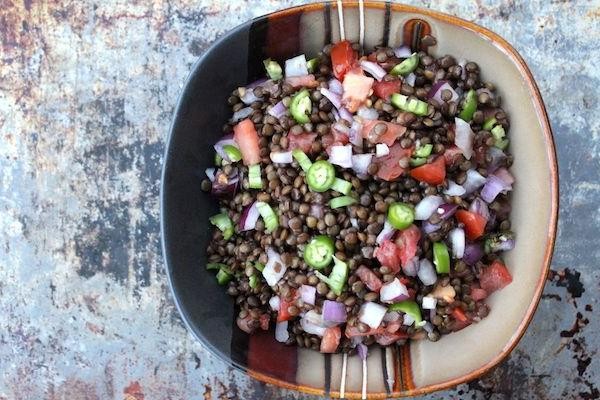
Brimming with vibrant flavors and textures, Azifa is a refreshing Ethiopian lentil salad that effortlessly combines simplicity with depth. This dish, a staple during fasting periods, is a testament to the beauty of plant-based ingredients coming together in harmony.
Ingredients
– 1 cup green lentils (I love how their earthy flavor stands out)
– 3 tbsp extra virgin olive oil (my go-to for its fruity notes)
– 1 small red onion, finely diced (for a sharp, crunchy contrast)
– 1 jalapeño, seeded and minced (adjust to your heat preference)
– 3 tbsp lemon juice (freshly squeezed, for that bright acidity)
– 1 tsp mustard (Dijon works wonders here)
– Salt to taste (I start with 1/2 tsp and adjust)
– 1/4 tsp black pepper (freshly ground, for aroma)
– 2 tbsp chopped cilantro (for a fresh, herbal finish)
Instructions
1. Rinse the lentils under cold water until the water runs clear, then drain.
2. In a medium saucepan, cover the lentils with 2 inches of water and bring to a boil over high heat.
3. Reduce heat to low, cover, and simmer for 20-25 minutes, or until the lentils are tender but not mushy.
4. Drain any excess water and let the lentils cool to room temperature. (Tip: Spreading them on a tray speeds up cooling.)
5. In a large bowl, whisk together the olive oil, lemon juice, mustard, salt, and black pepper until emulsified.
6. Add the cooled lentils, diced onion, and minced jalapeño to the bowl. Gently toss to coat everything in the dressing.
7. Let the salad sit for at least 10 minutes to allow the flavors to meld. (Tip: This resting time is crucial for depth of flavor.)
8. Before serving, stir in the chopped cilantro for a fresh lift.
9. Taste and adjust seasoning if necessary. (Tip: A pinch more salt can really brighten the flavors.)
Elegantly balanced, Azifa offers a delightful contrast of textures from the tender lentils to the crisp onions, with a dressing that brings a zesty, spicy kick. Serve it as a standalone salad or alongside injera for an authentic Ethiopian experience.
Kik Alicha (Yellow Split Pea Stew)
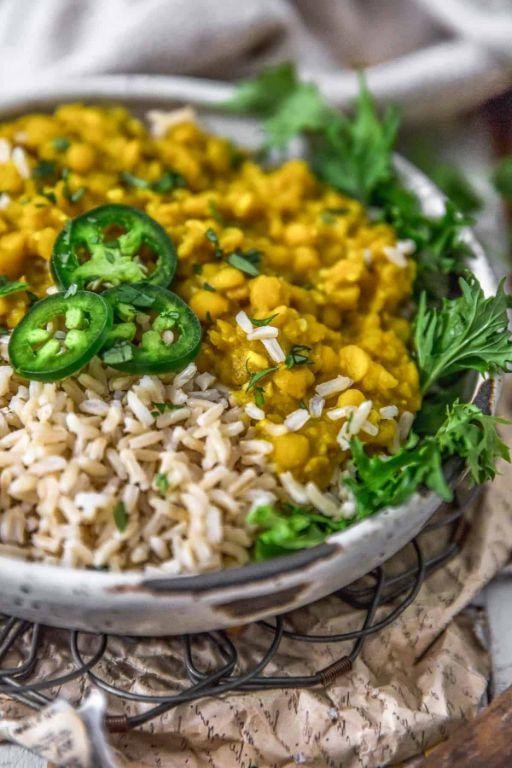
Savored across generations, Kik Alicha is a comforting Ethiopian yellow split pea stew that marries simplicity with depth, offering a velvety texture and a subtly spiced flavor profile that’s both nourishing and deeply satisfying.
Ingredients
- 2 cups yellow split peas (I love the slight sweetness they develop when cooked slowly)
- 1 large onion, finely diced (white or yellow onions work best for their sweetness)
- 3 cloves garlic, minced (freshly minced garlic makes all the difference)
- 1 tbsp ginger, grated (a microplane grater gives you the finest, most aromatic ginger)
- 1/4 cup extra virgin olive oil (my go-to for its fruity notes)
- 1 tsp turmeric (for that golden hue and earthy flavor)
- 4 cups water (filtered water ensures the purest taste)
- Salt to taste (I start with 1 tsp and adjust from there)
Instructions
- Rinse the yellow split peas under cold water until the water runs clear, then drain well.
- In a large pot, heat the olive oil over medium heat until shimmering but not smoking.
- Add the diced onion and sauté until translucent, about 5 minutes, stirring occasionally to prevent burning.
- Stir in the minced garlic and grated ginger, cooking for another minute until fragrant.
- Add the rinsed split peas to the pot, followed by the turmeric, stirring to coat the peas evenly with the spices.
- Pour in the water, bring to a boil, then reduce the heat to low, covering the pot with a lid.
- Simmer for 45 minutes to 1 hour, stirring occasionally, until the peas are tender and the stew has thickened.
- Season with salt, starting with 1 tsp and adjusting to your preference.
Mellow and creamy, this stew is a testament to the beauty of simple ingredients transformed. Serve it over a bed of fluffy basmati rice or with a side of injera for an authentic touch, letting its comforting warmth and subtle spices shine.
Ethiopian Spiced Rice

Amidst the bustling flavors of global cuisine, Ethiopian Spiced Rice stands out with its aromatic blend of spices and comforting warmth, a dish that invites you to explore the rich culinary traditions of Ethiopia from your own kitchen.
Ingredients
- 2 cups basmati rice – its long grains and fragrant aroma are perfect for absorbing the spices.
- 1 large onion, finely diced – I love the sweetness it brings when caramelized.
- 3 cloves garlic, minced – for that essential punch of flavor.
- 1 tbsp ginger, grated – fresh ginger elevates the dish with its zesty warmth.
- 1 tsp turmeric – not just for color, but for its earthy notes.
- 1 tsp cumin seeds – they add a nutty depth when toasted.
- 1/2 tsp cardamom powder – a little goes a long way in adding floral hints.
- 4 cups vegetable broth – I prefer low-sodium to control the saltiness.
- 2 tbsp extra virgin olive oil – my go-to for its fruity undertones.
- Salt to taste – though I’m sparing, letting the spices shine.
Instructions
- Heat the olive oil in a large pot over medium heat until shimmering, about 2 minutes.
- Add the cumin seeds and toast until fragrant, 30 seconds, stirring constantly to prevent burning.
- Stir in the onions, cooking until golden and caramelized, about 10 minutes, for a deep flavor base.
- Add the garlic and ginger, sautéing for another minute until aromatic.
- Mix in the turmeric and cardamom powder, stirring for 30 seconds to bloom the spices.
- Rinse the basmati rice under cold water until the water runs clear, then add it to the pot, coating the grains with the spiced onion mixture.
- Pour in the vegetable broth, bring to a boil, then reduce the heat to low, cover, and simmer for 15 minutes. Tip: Resist the urge to peek; steam is key to fluffy rice.
- After 15 minutes, turn off the heat and let the rice sit, covered, for 5 minutes to steam further. Tip: This step ensures each grain is perfectly tender.
- Fluff the rice with a fork before serving. Tip: A fork prevents the rice grains from breaking, keeping them intact and elegant.
Marvel at the vibrant yellow hue and the layers of flavor in each forkful of this Ethiopian Spiced Rice. Serve it alongside a crisp cucumber salad or as a bed for stews to soak up their rich sauces, making every bite a testament to the dish’s versatility and depth.
Vegan Doro Wat (Chickpea Version)
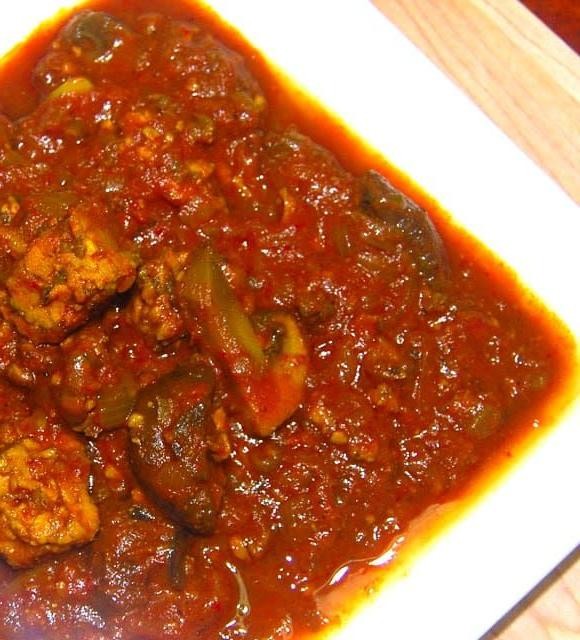
Hearty and deeply flavorful, this Vegan Doro Wat transforms the classic Ethiopian stew into a plant-based delight, using chickpeas as the star. Its rich, spicy berbere sauce and aromatic spices will transport your senses to the bustling streets of Addis Ababa.
Ingredients
- 2 cups cooked chickpeas (I love the creaminess of home-cooked, but canned works in a pinch)
- 3 tbsp extra virgin olive oil (my go-to for its fruity notes)
- 1 large onion, finely diced (yellow onions add a sweet depth)
- 3 garlic cloves, minced (freshly minced for that punchy aroma)
- 1 tbsp grated ginger (the fresher, the zingier)
- 2 tbsp berbere spice (adjust to your heat tolerance)
- 1 cup vegetable broth (homemade lends the best flavor)
- 1 tbsp tomato paste (for a concentrated umami boost)
- Salt to taste (I start with 1/2 tsp and adjust)
Instructions
- Heat olive oil in a large pot over medium heat until shimmering, about 2 minutes.
- Add the diced onion, stirring occasionally, until golden and caramelized, roughly 10 minutes.
- Stir in minced garlic and grated ginger, cooking for another minute until fragrant.
- Sprinkle in the berbere spice, toasting it with the onions for 30 seconds to unlock its flavors.
- Mix in the tomato paste, coating the onions and spices evenly, then pour in the vegetable broth.
- Add the chickpeas, bringing the mixture to a simmer. Let it cook uncovered for 20 minutes, allowing the sauce to thicken.
- Season with salt, tasting and adjusting as needed. Tip: Letting the stew sit for 10 minutes off the heat deepens the flavors.
Just as it is, this Vegan Doro Wat boasts a velvety sauce clinging to tender chickpeas, with a heat that builds gracefully. Serve it atop injera or with a side of quinoa for a wholesome meal that delights with every bite.
Tikil Gomen (Ethiopian Cabbage Dish)

Gracefully blending simplicity with depth, Tikil Gomen is a vibrant Ethiopian cabbage dish that marries tender vegetables with aromatic spices, offering a comforting yet exotic flavor profile that’s both nourishing and deeply satisfying.
Ingredients
- 1 large head of green cabbage, thinly sliced (I find the pre-shredded bags too thick for this dish)
- 3 large carrots, julienned (for a sweet crunch)
- 1 large onion, thinly sliced (yellow onions are my preference for their balance of sweetness and sharpness)
- 3 cloves garlic, minced (freshly minced garlic elevates the dish immensely)
- 1 inch ginger, grated (for that warm, spicy kick)
- 1/4 cup extra virgin olive oil (my go-to for its fruity notes)
- 1 tsp turmeric powder (for color and earthiness)
- 1 tsp cumin seeds (toasted and ground, if you have the time)
- Salt to taste (I start with 1/2 tsp and adjust)
Instructions
- Heat the olive oil in a large skillet over medium heat until shimmering, about 2 minutes.
- Add the cumin seeds and let them sizzle for about 30 seconds, until fragrant, toasting them slightly.
- Stir in the onions, cooking until translucent and slightly golden, about 5 minutes, stirring occasionally.
- Add the garlic and ginger, cooking for another minute until fragrant, being careful not to burn them.
- Mix in the turmeric, stirring well to coat the onions evenly, which helps to bloom the spice’s flavor.
- Add the carrots and cabbage, tossing to combine with the onion mixture. The volume will seem large at first, but it will reduce significantly.
- Cover the skillet and reduce the heat to low, allowing the vegetables to steam and soften, about 15 minutes, stirring halfway through.
- Remove the lid, increase the heat to medium, and cook for an additional 5 minutes to evaporate any excess moisture and concentrate the flavors.
- Season with salt, starting with 1/2 tsp and adjusting to your preference, then give everything a final stir.
Delightfully tender with a slight bite, the cabbage and carrots meld beautifully with the earthy turmeric and warm cumin, creating a dish that’s as versatile as it is flavorful. Serve it alongside injera for an authentic experience or as a vibrant side to grilled meats for a contemporary twist.
Ye’abesha Gomen (Ethiopian Kale)
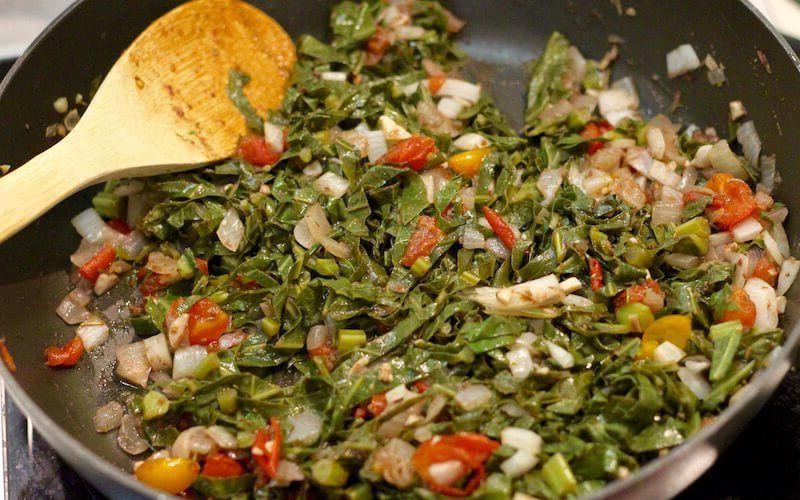
Kale transforms into a dish of sublime simplicity and depth in Ye’abesha Gomen, a staple of Ethiopian cuisine that celebrates the earthy, slightly bitter greens with a melody of spices and slow-cooked onions.
Ingredients
- 1 large bunch of kale, stems removed and leaves chopped (about 6 cups packed)—I find the darker the leaves, the richer the flavor.
- 1/4 cup extra virgin olive oil—my go-to for its fruity notes that complement the greens.
- 1 large yellow onion, thinly sliced—the sweetness balances the kale’s bitterness beautifully.
- 3 cloves garlic, minced—because what’s a dish without garlic’s punch?
- 1 teaspoon ground turmeric—for that golden hue and subtle earthiness.
- 1/2 teaspoon ground cumin—a whisper of warmth that ties everything together.
- Salt to taste—I start with 1/2 teaspoon and adjust from there.
- 1/4 cup water—just enough to help the kale soften without losing its character.
Instructions
- Heat the olive oil in a large skillet over medium heat until shimmering, about 2 minutes—this ensures the onions will sauté evenly.
- Add the sliced onions and cook, stirring occasionally, until they’re golden and caramelized, about 15 minutes. Patience here builds a flavor foundation.
- Stir in the minced garlic, turmeric, and cumin, cooking for just 30 seconds until fragrant—this quick step unlocks the spices’ aromas without burning them.
- Add the chopped kale in batches, stirring each addition until slightly wilted before adding more—this makes managing the volume easier.
- Pour in the water, then cover the skillet and reduce the heat to low. Let the kale simmer for 10 minutes, stirring once halfway through—the steam tenderizes the leaves perfectly.
- Uncover, season with salt, and cook for another 2 minutes to let any excess water evaporate—this concentrates the flavors.
Just as it is, Ye’abesha Gomen offers a tender yet vibrant texture, with layers of flavor from the sweet onions and warm spices. Serve it alongside injera for an authentic experience, or as a bold side to grilled meats for a contemporary twist.
Ethiopian Lentil Sambusa

Kickstarting our culinary journey today, we delve into the heart of Ethiopian cuisine with a dish that’s as rich in flavor as it is in history—Ethiopian Lentil Sambusa. These golden, crispy parcels are a vegetarian twist on the traditional sambusa, filled with a spiced lentil mixture that’s both hearty and aromatic.
Ingredients
- 1 cup green lentils (I find they hold their shape better than red lentils)
- 2 tbsp extra virgin olive oil (my go-to for its fruity notes)
- 1 large onion, finely diced (the sweetness balances the spices beautifully)
- 2 cloves garlic, minced (fresh is always best for that pungent kick)
- 1 tbsp ginger, grated (adds a warm, zesty depth)
- 1 tsp cumin seeds (toasted for an earthy aroma)
- 1 tsp coriander powder (for a citrusy undertone)
- 1/2 tsp turmeric (just a pinch for color and health benefits)
- 1/4 tsp cayenne pepper (adjust to your heat preference)
- Salt, to taste (I prefer sea salt for its clean flavor)
- Spring roll or samosa wrappers (thawed if frozen, for easy handling)
- Oil for frying (a neutral oil like vegetable works best for high heat)
Instructions
- Rinse the lentils under cold water until the water runs clear, then soak them in warm water for 30 minutes to soften.
- In a medium saucepan, heat the olive oil over medium heat. Add the onions and sauté until translucent, about 5 minutes.
- Stir in the garlic and ginger, cooking for another minute until fragrant. Tip: Keep the heat moderate to avoid burning the garlic.
- Drain the lentils and add them to the pan along with the cumin, coriander, turmeric, cayenne, and salt. Stir well to coat the lentils in the spices.
- Add 2 cups of water, bring to a boil, then reduce the heat to low. Cover and simmer for 20 minutes, or until the lentils are tender but not mushy. Tip: Check occasionally to ensure there’s enough water; add a splash more if needed.
- Once cooked, remove from heat and let the mixture cool slightly. Meanwhile, prepare your wrappers by separating them and covering with a damp cloth to prevent drying.
- Place a tablespoon of the lentil mixture in the center of each wrapper. Fold according to package instructions, sealing the edges with a bit of water.
- Heat oil in a deep fryer or large pan to 350°F. Fry the sambusas in batches until golden brown, about 3-4 minutes per side. Tip: Don’t overcrowd the pan to ensure even cooking.
- Remove with a slotted spoon and drain on paper towels.
Lusciously crispy on the outside with a spiced, tender lentil filling, these sambusas are a delight to the senses. Serve them with a side of tangy tamarind chutney or a cooling yogurt dip for a contrast in flavors that’s simply irresistible.
Vegan Kitfo (Minced Walnut Dish)
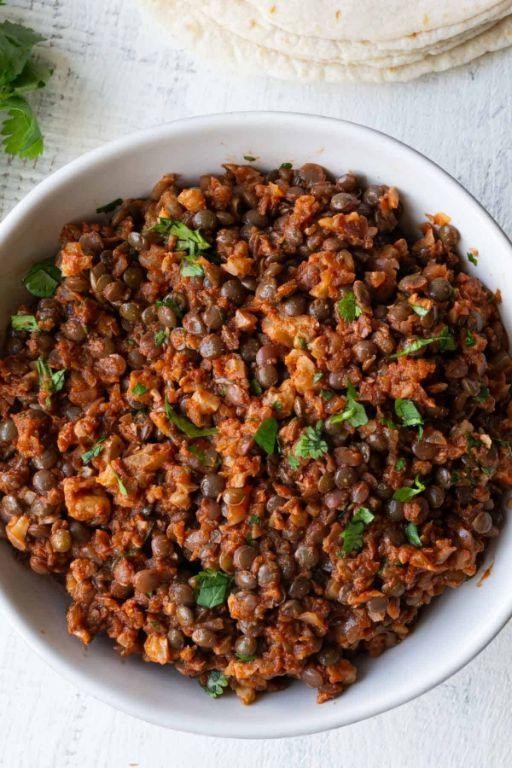
Kitfo, traditionally a spiced Ethiopian beef dish, finds its plant-based counterpart in this Vegan Kitfo, where minced walnuts take center stage, offering a rich, nutty base that’s beautifully spiced and surprisingly meaty in texture.
Ingredients
- 2 cups raw walnuts (soaked overnight for a creamier texture)
- 3 tbsp extra virgin olive oil (my go-to for its fruity notes)
- 1 tbsp berbere spice (adjust to your heat preference)
- 1 tsp smoked paprika (for that deep, smoky undertone)
- 1/2 tsp ground cardamom (a little goes a long way)
- 1/4 cup finely chopped red onion (for a crisp bite)
- 1 tbsp lemon juice (freshly squeezed, please)
- Salt to taste (I prefer Himalayan pink salt for its mineral richness)
Instructions
- Drain the soaked walnuts and pat them dry with a clean kitchen towel to remove excess moisture.
- In a food processor, pulse the walnuts until they resemble coarse crumbs, being careful not to over-process into a paste.
- Heat the olive oil in a skillet over medium heat (around 300°F) until shimmering but not smoking.
- Add the minced walnuts to the skillet, stirring frequently to toast lightly, about 3 minutes, until fragrant.
- Sprinkle in the berbere spice, smoked paprika, and ground cardamom, stirring to coat the walnuts evenly for a minute to bloom the spices.
- Remove the skillet from heat and fold in the chopped red onion and lemon juice, adjusting the salt to your liking.
- Let the mixture sit for 5 minutes to allow the flavors to meld together beautifully.
Zesty and vibrant, this Vegan Kitfo boasts a delightful crunch from the walnuts and a warm, spicy kick from the berbere. Serve it atop a bed of fresh greens or with injera for an authentic Ethiopian experience.
Ethiopian Potato and Carrot Stew
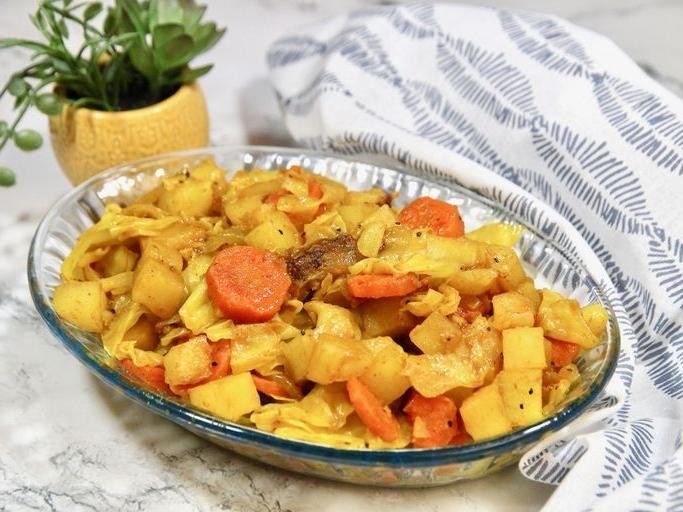
Brimming with vibrant flavors and comforting warmth, this Ethiopian Potato and Carrot Stew is a delightful exploration of East African cuisine, perfect for those seeking a hearty yet healthy meal. Its rich, spiced broth and tender vegetables make it a standout dish that’s as nourishing as it is flavorful.
Ingredients
- 2 tablespoons extra virgin olive oil (my go-to for its fruity notes)
- 1 large onion, finely chopped (I find sweet onions work best here)
- 3 cloves garlic, minced (freshly minced for that punch of flavor)
- 1 tablespoon ginger, grated (a little extra adds a nice zing)
- 1 teaspoon turmeric (for that golden hue and earthy taste)
- 1 teaspoon cumin (toasted and ground for maximum aroma)
- 1/2 teaspoon cardamom (a personal favorite for its floral notes)
- 4 medium potatoes, peeled and cubed (Yukon Golds are my choice for their buttery texture)
- 3 large carrots, peeled and sliced into rounds (for a sweet crunch)
- 4 cups vegetable broth (homemade is ideal, but store-bought works in a pinch)
- Salt to taste (I start with 1/2 teaspoon and adjust from there)
- Fresh cilantro, chopped (for garnish, and I’m generous with it)
Instructions
- Heat the olive oil in a large pot over medium heat until shimmering, about 2 minutes.
- Add the chopped onion and sauté until translucent, stirring occasionally, about 5 minutes.
- Stir in the minced garlic and grated ginger, cooking until fragrant, about 1 minute. Tip: Keep the heat medium to avoid burning the garlic.
- Add the turmeric, cumin, and cardamom, stirring to coat the onions, about 30 seconds. Tip: Toasting the spices beforehand enhances their flavors.
- Mix in the potatoes and carrots, ensuring they’re well coated with the spice mixture, about 2 minutes.
- Pour in the vegetable broth, bringing the mixture to a boil. Then, reduce the heat to low, cover, and simmer until the vegetables are tender, about 20 minutes. Tip: Check the potatoes with a fork for doneness.
- Season with salt to taste, then garnish with fresh cilantro before serving.
Now, this stew boasts a velvety texture with the potatoes melting slightly into the broth, while the carrots retain a pleasant bite. The layers of spice create a complex flavor profile that’s both warming and inviting. Serve it over a bed of fluffy quinoa or with a side of injera for an authentic Ethiopian experience.
Fasolia (Ethiopian Green Bean Dish)

Hailing from the vibrant culinary traditions of Ethiopia, Fasolia is a comforting green bean dish that marries simplicity with depth of flavor, perfect for a wholesome weeknight dinner or a festive side.
Ingredients
- 1 lb fresh green beans, trimmed and halved (the crunchier, the better for that satisfying bite)
- 2 tbsp extra virgin olive oil (my go-to for its fruity notes)
- 1 large onion, finely diced (yellow onions work wonders here for their sweetness)
- 2 cloves garlic, minced (because garlic makes everything better)
- 1 tsp ground cumin (toasted and ground at home if you’re feeling adventurous)
- 1/2 tsp turmeric (for that golden hue and earthy undertones)
- 1/2 cup water (just enough to steam the beans to perfection)
- Salt to taste (I like to start with 1/2 tsp and adjust from there)
Instructions
- Heat the olive oil in a large skillet over medium heat until shimmering, about 2 minutes. This ensures the onions will sauté evenly.
- Add the diced onions to the skillet, stirring occasionally, until they turn translucent and slightly golden, about 5 minutes. Tip: Lower the heat if they start to brown too quickly.
- Stir in the minced garlic, cumin, and turmeric, cooking for just 30 seconds until fragrant. This quick step unlocks the spices’ full aroma.
- Add the green beans to the skillet, tossing to coat them evenly with the onion and spice mixture. Tip: Use tongs for an easy mix.
- Pour in the water, then cover the skillet with a lid. Reduce the heat to low and let the beans steam for 10 minutes, or until tender but still crisp. Tip: Check halfway to ensure they’re cooking evenly.
- Remove the lid, increase the heat to medium, and cook for another 2 minutes to evaporate any excess water, stirring occasionally.
- Season with salt, give it one final stir, and remove from heat.
The Fasolia emerges with a vibrant green hue, its flavors a harmonious blend of earthy spices and the natural sweetness of the beans. Try serving it atop a warm injera for an authentic Ethiopian experience, or as a bright side to grilled meats.
Ethiopian Beetroot Salad
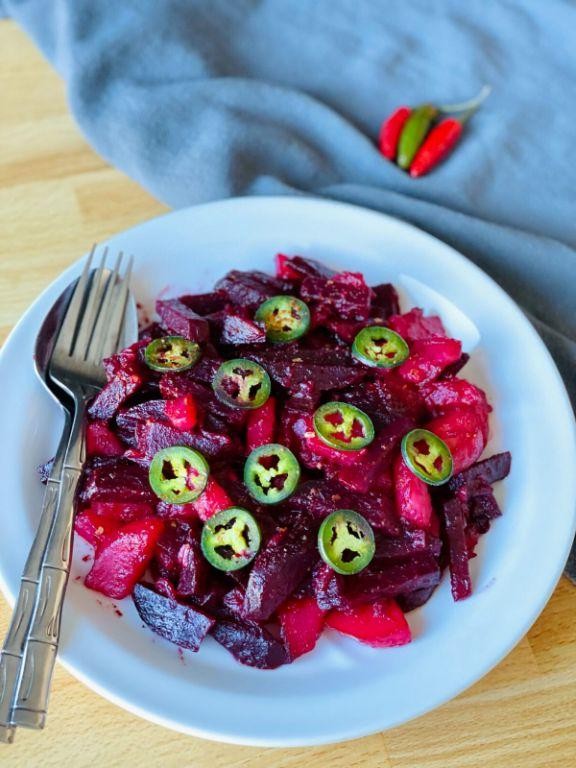
Just when you thought beetroot couldn’t get any more vibrant, this Ethiopian Beetroot Salad comes along, turning the humble root vegetable into a dazzling, flavor-packed dish that’s as nutritious as it is beautiful.
Ingredients
- 2 medium beetroots, peeled and diced into 1/2-inch cubes (I find the smaller cubes absorb the dressing better)
- 1/4 cup extra virgin olive oil (my go-to for its fruity notes)
- 2 tbsp fresh lemon juice (for that bright, tangy kick)
- 1 tsp ground cumin (toasted and freshly ground if you have the time)
- 1/2 tsp salt (I prefer sea salt for its clean taste)
- 1/4 tsp black pepper (freshly cracked, please)
- 2 tbsp chopped fresh cilantro (because its freshness is unmatched)
- 1 small red onion, thinly sliced (for a sharp contrast)
Instructions
- Preheat your oven to 400°F (200°C). This ensures a perfectly roasted beetroot.
- Toss the diced beetroots with 1 tbsp of the olive oil, making sure each piece is lightly coated. Spread them out on a baking sheet in a single layer to ensure even roasting.
- Roast in the preheated oven for 25 minutes, or until the beetroots are tender when pierced with a fork. Tip: Stir halfway through for uniform cooking.
- While the beetroots roast, whisk together the remaining olive oil, lemon juice, cumin, salt, and black pepper in a large bowl. This dressing will marry all the flavors beautifully.
- Add the roasted beetroots, sliced red onion, and chopped cilantro to the bowl with the dressing. Gently toss to combine, ensuring every piece is dressed. Tip: Let the salad sit for 10 minutes before serving to allow the flavors to meld.
- Serve the salad at room temperature to appreciate its full spectrum of flavors. Tip: For an extra touch, sprinkle with additional cilantro or a drizzle of olive oil before serving.
The salad boasts a delightful contrast between the earthy sweetness of the beetroots and the sharpness of the red onion, all brought together by the zesty dressing. Try serving it alongside grilled meats or as part of a mezze platter for a pop of color and flavor.
Vegan Ethiopian Breakfast Porridge

Perfectly balancing warmth and spice, this Vegan Ethiopian Breakfast Porridge is a morning delight that transports your senses to the heart of Addis Ababa with every spoonful. Its creamy texture and aromatic blend of spices make it an unforgettable start to the day.
Ingredients
- 1 cup teff flour (I find Bob’s Red Mill offers the finest texture)
- 3 cups water (filtered for the purest taste)
- 1/2 tsp salt (Himalayan pink salt adds a subtle mineral richness)
- 1 tbsp coconut oil (extra virgin for its fragrant aroma)
- 1/4 tsp ground cardamom (a little goes a long way in elevating the dish)
- 1/4 tsp ground cinnamon (Ceylon cinnamon is my preference for its sweet complexity)
- 1 tbsp maple syrup (organic, grade A for its deep caramel notes)
Instructions
- In a medium saucepan, whisk together the teff flour and water until no lumps remain.
- Place the saucepan over medium heat and bring the mixture to a gentle boil, stirring constantly to prevent sticking.
- Reduce the heat to low and simmer for 15 minutes, stirring occasionally, until the porridge thickens to a creamy consistency.
- Stir in the salt, coconut oil, cardamom, and cinnamon, blending well to incorporate all the flavors.
- Cook for an additional 5 minutes, allowing the spices to meld beautifully with the teff.
- Remove from heat and drizzle with maple syrup, stirring gently to combine.
Whisking this porridge to perfection yields a velvety texture that’s both comforting and invigorating. Serve it topped with a sprinkle of cinnamon or fresh berries for a vibrant contrast to its earthy tones.
Ethiopian Spiced Avocado Salad
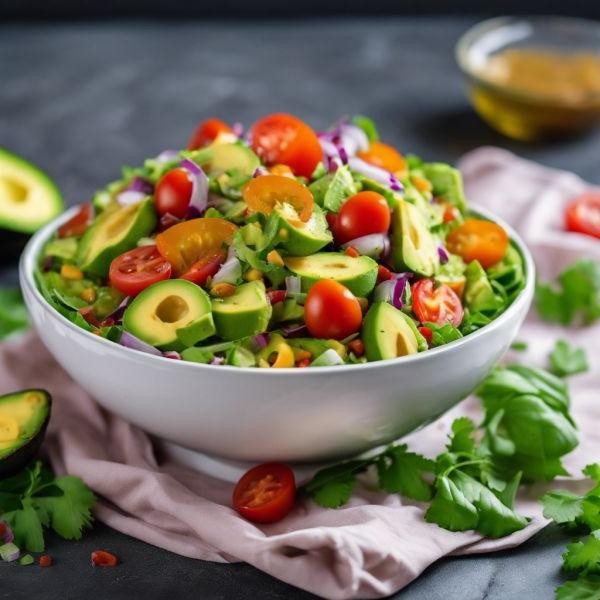
Crafting a dish that bridges continents and flavors, this Ethiopian Spiced Avocado Salad is a vibrant celebration of textures and tastes, perfect for those seeking a refreshing yet deeply flavorful side or light meal.
Ingredients
- 2 ripe avocados, cubed (I find Hass avocados work best for their creamy texture)
- 1 cup cherry tomatoes, halved (a mix of colors adds a beautiful visual appeal)
- 1/4 cup red onion, finely diced (soaking in cold water for 10 minutes tames the sharpness)
- 2 tbsp extra virgin olive oil (my go-to for its fruity notes)
- 1 tbsp lemon juice (freshly squeezed makes all the difference)
- 1 tsp Ethiopian berbere spice (adjust to your heat preference)
- 1/2 tsp salt (I prefer sea salt for its clean taste)
- 1/4 cup cilantro, chopped (for a fresh, herby finish)
Instructions
- In a large mixing bowl, gently combine the cubed avocados, halved cherry tomatoes, and finely diced red onion.
- Drizzle the extra virgin olive oil and freshly squeezed lemon juice over the avocado mixture, ensuring even coverage.
- Sprinkle the Ethiopian berbere spice and sea salt over the salad, then toss lightly to distribute the spices without mashing the avocados.
- Let the salad sit for 5 minutes to allow the flavors to meld together beautifully.
- Just before serving, sprinkle the chopped cilantro over the top for a burst of color and freshness.
Zesty and bold, this salad offers a creamy contrast from the avocados against the juicy pop of tomatoes, all brought together with the warm, complex notes of berbere. Serve it alongside grilled flatbread for scooping up every last bite, or as a vibrant topping for a grain bowl.
Ye’misr Wot (Ethiopian Lentil Curry)

Nothing quite compares to the rich, aromatic depths of Ye’misr Wot, a beloved Ethiopian lentil curry that marries simplicity with profound flavor. This dish, a staple in Ethiopian cuisine, offers a comforting embrace with its velvety lentils and a symphony of spices, perfect for those seeking warmth and nourishment.
Ingredients
- 1 cup red lentils, rinsed until the water runs clear – their quick cooking time makes them ideal for weeknight dinners.
- 2 tbsp extra virgin olive oil – my go-to for its fruity notes that complement the spices.
- 1 large onion, finely diced – the foundation of flavor in any great curry.
- 3 cloves garlic, minced – because garlic is life.
- 1 tbsp berbere spice – adjust to your heat preference, but don’t skip it; it’s the soul of the dish.
- 4 cups vegetable broth – homemade is best, but a good quality store-bought works in a pinch.
- Salt to taste – I start with 1/2 tsp and adjust from there.
Instructions
- Heat the olive oil in a large pot over medium heat until shimmering, about 2 minutes.
- Add the diced onion and cook, stirring occasionally, until golden and translucent, about 5 minutes.
- Stir in the minced garlic and berbere spice, cooking for another minute until fragrant – this blooms the spices, unlocking their full potential.
- Pour in the rinsed lentils and vegetable broth, bringing the mixture to a gentle boil.
- Reduce the heat to low, cover, and simmer for 20-25 minutes, or until the lentils are tender and the curry has thickened. Stir occasionally to prevent sticking.
- Season with salt, starting with 1/2 tsp and adjusting as needed. Remember, you can always add more, but you can’t take it away.
Best enjoyed when the lentils are luxuriously soft, and the flavors have melded into a harmonious blend. Serve this Ye’misr Wot over a bed of fluffy injera or steamed rice for a meal that’s as nourishing as it is delicious.
Vegan Ethiopian Coffee Chocolate Cake

Never has there been a more harmonious blend of flavors than in this Vegan Ethiopian Coffee Chocolate Cake, where the rich, earthy tones of Ethiopian coffee meet the deep, velvety embrace of dark chocolate. This cake is a testament to the beauty of plant-based baking, offering a decadent experience that’s both sophisticated and comforting.
Ingredients
- 1 1/2 cups all-purpose flour (I always sift mine for a lighter texture)
- 1 cup granulated sugar (organic cane sugar adds a lovely depth)
- 1/3 cup unsweetened cocoa powder (the darker, the better for that intense chocolate flavor)
- 1 tsp baking soda (freshness is key to a good rise)
- 1/2 tsp salt (I prefer sea salt for its subtle minerality)
- 1 cup strong brewed Ethiopian coffee, cooled (the heart of the cake, choose a blend with floral notes)
- 1/3 cup vegetable oil (a neutral oil lets the other flavors shine)
- 2 tsp apple cider vinegar (this reacts with the baking soda for lift)
- 1 tsp pure vanilla extract (a splash of this elevates the entire cake)
Instructions
- Preheat your oven to 350°F (175°C) and lightly grease an 8-inch round cake pan, lining the bottom with parchment paper for easy removal.
- In a large mixing bowl, whisk together the flour, sugar, cocoa powder, baking soda, and salt until well combined and free of lumps.
- Pour in the cooled Ethiopian coffee, vegetable oil, apple cider vinegar, and vanilla extract into the dry ingredients. Stir until just combined; overmixing can lead to a dense cake.
- Tip: Use a spatula to gently fold the wet ingredients into the dry, ensuring you scrape the bottom of the bowl to incorporate all the flour.
- Pour the batter into the prepared cake pan, smoothing the top with the back of a spoon for an even bake.
- Bake for 30-35 minutes, or until a toothpick inserted into the center comes out clean. Tip: The cake should spring back when lightly pressed, a sign it’s perfectly done.
- Allow the cake to cool in the pan for 10 minutes before transferring to a wire rack to cool completely. Tip: For an extra moist cake, brush the top with a little more brewed coffee while it’s still warm.
Zesty with the boldness of Ethiopian coffee and rich with the depth of chocolate, this cake boasts a moist, tender crumb that’s irresistibly light. Serve it with a dusting of cocoa powder or a dollop of coconut whipped cream for an elegant finish that complements its complex flavors.
Conclusion
Unquestionably, this roundup of 22 Delicious Vegan Ethiopian Recipes offers a treasure trove of flavors for every occasion, from cozy family dinners to festive gatherings. We hope these dishes inspire your next meal. Don’t forget to leave a comment sharing your favorites and pin the recipes you love on Pinterest to spread the joy of vegan Ethiopian cuisine!


